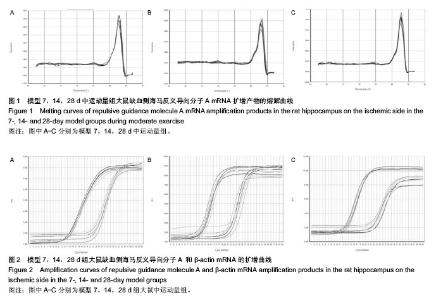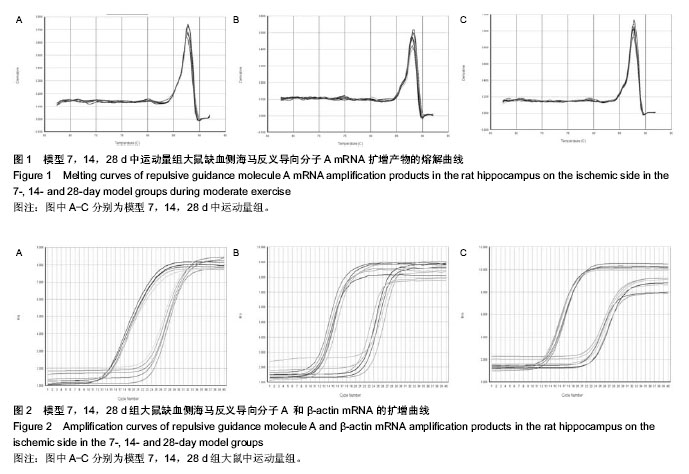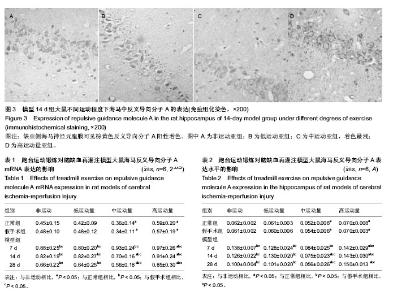Chinese Journal of Tissue Engineering Research ›› 2015, Vol. 19 ›› Issue (5): 685-690.doi: 10.3969/j.issn.2095-4344.2015.05.006
Previous Articles Next Articles
Expression of repulsive guidance molecule A in the hippocampus of rat models of cerebral ischemia-reperfusion injury during treadmill exercise
Guo Zhen-wei1, Qin Xin-yue2, Zhang Guang-hui1
- 1Department of Neurology, Lianyungang Municipal First People’s Hospital, Xuzhou Medical College, Lianyungang 222002, Jiangsu Province, China
2Department of Neurology, First Affiliated Hospital of Chongqing Medical University, Chongqing 400042, China
-
Revised:2014-11-14Online:2015-01-30Published:2015-03-02 -
About author:Guo Zhen-wei, Master, Physician, Department of Neurology, Lianyungang Municipal First People’s Hospital, Xuzhou Medical College, Lianyungang 222002, Jiangsu Province, China
CLC Number:
Cite this article
Guo Zhen-wei, Qin Xin-yue, Zhang Guang-hui. Expression of repulsive guidance molecule A in the hippocampus of rat models of cerebral ischemia-reperfusion injury during treadmill exercise[J]. Chinese Journal of Tissue Engineering Research, 2015, 19(5): 685-690.
share this article

2.1 实验动物数量分析 有15只大鼠在大脑中动脉缺血/再灌注模型制备中死亡,大鼠补足后,共120只进入结果分析。 2.2 跑台运动锻炼对脑缺血再灌注模型大鼠海马反义导向分子A mRNA表达的影响 用ABI7500配套程序分析软件生成反义导向分子A熔解曲线,反义导向分子A基因PCR产物的熔解曲线峰值约在87 ℃,熔解温度均一。反义导向分子A熔解曲线峰值高,形状锐利示反义导向分子A表达较高,产物特异(图1)。SYBR Green 实时定量PCR部分扩增曲线见图2。非运动时,模型7 d组大鼠缺血侧海马反义导向分子A mRNA表达水平最高,且反义导向分子A相对表达水平随时间延长而逐渐降低。而正常组、假手术组和模型7,14,28 d组大鼠缺血侧海马反义导向分子A mRNA表达水平差异无显著性意义(P > 0.05)。与非运动相比,模型14,28 d组大鼠中运动量时缺血侧海马反义导向分子A mRNA表达水平明显下降(P < 0.05),而高运动量海马反义导向分子A mRNA表达水平表达增加(P < 0.05,见表1)。"

| [1] Schimidt HL, Vieira A, Altermann C, et al. Memory deficits and oxidative stress in cerebral ischemia-reperfusion: neuroprotective role of physical exercise and green tea supplementation. Neurobiol Learn Mem. 2014;114:242-250. [2] Wu YY, Wu WY, Gong HL, et al. Astragalosides attenuate learning and memory impairment in rats following ischemia?reperfusion injury. Mol Med Rep. 2014;9(4):1319-1324. [3] Shih PC, Yang YR, Wang RY. Effects of exercise intensity on spatial memory performance and hippocampal synaptic plasticity in transient brain ischemic rats. PLoS One. 2013; 8(10): e78163. [4] Luo CX, Jiang J, Zhou QG, et al. Voluntary exercise-induced neurogenesis in the postischemic dentate gyrus is associated with spatial memory recovery from stroke. J Neurosci Res. 2007; 85(8):1637-1646. [5] Hata K, Fujitani M, Yasuda Y, et al. RGMa inhibition promotes axonal growth and recovery after spinal cord injury. J Cell Biol. 2006;173(1):47-58. [6] Feng J, Wang T, Li Q, et al. RNA interference against repulsive guidance molecule A improves axon sprout and neural function recovery of rats after MCAO/reperfusion. Exp Neurol. 2012;238(2):235-242. [7] Wang T, Wu X, Yin C, et al. CRMP-2 is involved in axon growth inhibition induced by RGMa in vitro and in vivo. Mol Neurobiol. 2013;47(3):903-913. [8] Jiang F, Yin H, Qin X. Fastigial nucleus electrostimulation reduces the expression of repulsive guidance molecule, improves axonal growth following focal cerebral ischemia. Neurochem Res. 2012;37(9):1906-1914. [9] Zhang G, Zhang JH, Feng J, et al. Electrical stimulation of olfactory bulb downregulates RGMa expression after ischemia/reperfusion injury in rats. Brain Res Bull. 2011;86 (3-4): 254-261. [10] Wang X, Zhang M, Feng R, et al. Exercise pre?conditioning alleviates brain damage via excitatory amino acid transporter 2 and extracellular signal?regulated kinase 1/2 following ischemic stroke in rats. Mol Med Rep. 2014. in press. [11] Wang SS, Wang JJ, Wang PX, et al. Determinants of Fatigue after First-Ever Ischemic Stroke during Acute Phase. PLoS One. 2014;9(10):e110037. [12] Feng R, Zhang M, Wang X, et al. Pre-ischemic exercise alleviates oxidative damage following ischemic stroke in rats. Exp Ther Med. 2014;8(4):1325-1329. [13] Gao Y, Zhao Y, Pan J, et al. Treadmill exercise promotes angiogenesis in the ischemic penumbra of rat brains through caveolin-1/VEGF signaling pathways. Brain Res. 2014;1585: 83-90. [14] Luo J, Hu X, Zhang L, et al. Physical exercise regulates neural stem cells proliferation and migration via SDF-1α/CXCR4 pathway in rats after ischemic stroke. Neurosci Lett. 2014;578:203-208. [15] Zheng HQ, Zhang LY, Luo J, et al. Physical exercise promotes recovery of neurological function after ischemic stroke in rats. Int J Mol Sci. 2014;15(6):10974-10988. [16] Schmidt A, Wellmann J, Schilling M, et al. Meta-analysis of the efficacy of different training strategies in animal models of ischemic stroke. Stroke. 2014;45(1):239-247. [17] Longa EZ, Weinstein PR, Carlson S, et al. Reversible middle cerebral artery occlusion without craniectomy in rats. Stroke. 1989;20(1):84-91. [18] Nagasawa H, Kogure K. Correlation between cerebral blood flow and histologic changes in a new rat model of middle cerebral artery occlusion. Stroke. 1989;20(8):1037-1043. [19] Cechetti F, Rhod A, Simão F, et al. Effect of treadmill exercise on cell damage in rat hippocampal slices submitted to oxygen and glucose deprivation. Brain Res. 2007;1157:121-125. [20] Scopel D, Fochesatto C, Cimarosti H, et al. Exercise intensity influences cell injury in rat hippocampal slices exposed to oxygen and glucose deprivation. Brain Res Bull. 2006;71(1-3): 155-159. [21] Cechetti F, Worm PV, Elsner VR, et al. Forced treadmill exercise prevents oxidative stress and memory deficits following chronic cerebral hypoperfusion in the rat. Neurobiol Learn Mem. 2012;97(1):90-96. [22] Alipanahzadeh H, Soleimani M, Soleimani Asl S, et al. Transforming Growth Factor-α Improves Memory Impairment and Neurogenesis Following Ischemia Reperfusion. Cell J. 2014;16(3):315-324. [23] Collino M, Aragno M, Mastrocola R, et al. Modulation of the oxidative stress and inflammatory response by PPAR-gamma agonists in the hippocampus of rats exposed to cerebral ischemia/reperfusion. Eur J Pharmacol. 2006;530(1-2):70-80. [24] Cîrneci D, Silaghi-Dumitrescu R. Learning tasks as a possible treatment for DNA lesions induced by oxidative stress in hippocampal neurons. Neural Regen Res. 2013; 8(32): 3063-3070. [25] van Praag H. Neurogenesis and exercise: past and future directions. Neuromolecular Med. 2008;10(2):128-140. [26] Vivar C, Potter MC, van Praag H. All about running: synaptic plasticity, growth factors and adult hippocampal neurogenesis. Curr Top Behav Neurosci. 2013;15:189-210. [27] Voss MW, Vivar C, Kramer AF, et al. Bridging animal and human models of exercise-induced brain plasticity. Trends Cogn Sci. 2013;17(10):525-544. [28] Yin Y, Gu Z, Pan L, et al. Lu Gan1,How does the motor relearning program improve neurological function of brain ischemia monkeys? Neural Regen Res. 2013; 8(16): 1445-1454. [29] Mueller BK, Yamashita T, Schaffar G, et al. The role of repulsive guidance molecules in the embryonic and adult vertebrate central nervous system. Philos Trans R Soc Lond B Biol Sci. 2006;361(1473):1513-1529. [30] Schwab JM, Conrad S, Monnier PP, et al. Spinal cord injury-induced lesional expression of the repulsive guidance molecule (RGM). Eur J Neurosci. 2005;21(6):1569-1576. [31] Yin HL, Wang YL, Li JF, et al. Effects of curcumin on hippocampal expression of NgR and axonal regeneration in Aβ-induced cognitive disorder rats. Genet Mol Res. 2014; 13(1):2039-2047. [32] Severyn CJ, Shinde U, Rotwein P. Molecular biology, genetics and biochemistry of the repulsive guidance molecule family. Biochem J. 2009;422(3):393-403. [33] Schwab JM, Monnier PP, Schluesener HJ, et al. Central nervous system injury-induced repulsive guidance molecule expression in the adult human brain. Arch Neurol. 2005;62 (10): 1561-1568. [34] Zhang A, Bai Y, Hu Y, et al. The effects of exercise intensity on p-NR2B expression in cerebral ischemic rats. Can J Neurol Sci. 2012;39(5):613-618. [35] Zhang Q, Wu Y, Zhang P, et al. Exercise induces mitochondrial biogenesis after brain ischemia in rats. Neuroscience. 2012;205:10-17. [36] Kim G, Kim E. Effects of treadmill training on limb motor function and acetylcholinesterase activity in rats with stroke. J Phys Ther Sci. 2013;25(10):1227-1230. [37] Martins DF, Mazzardo-Martins L, Soldi F, et al. High-intensity swimming exercise reduces neuropathic pain in an animal model of complex regional pain syndrome type I: evidence for a role of the adenosinergic system. Neuroscience. 2013;234: 69-76. [38] Shih PC, Yang YR, Wang RY. Effects of exercise intensity on spatial memory performance and hippocampal synaptic plasticity in transient brain ischemic rats. PLoS One. 2013; 8(10): e78163. [39] Yang YR, Chang HC, Wang PS, et al. Motor performance improved by exercises in cerebral ischemic rats. J Mot Behav. 2012;44(2):97-103. [40] Dimyan MA, Cohen LG. Neuroplasticity in the context of motor rehabilitation after stroke. Nat Rev Neurol. 2011;7(2):76-85. |
| [1] | Liu Jinyu, Zhang Hanshuo, Cui Hongpeng, Pan Lingzhi, Zhao Boran, Li Fei, Ding Yu. Finite element biomechanical analysis of minimally invasive treatment of cervical spondylotic myelopathy and accurate exercise rehabilitation [J]. Chinese Journal of Tissue Engineering Research, 2023, 27(9): 1359-1364. |
| [2] | Jia Shengqi, Luo Wenlong, Tian Dingyuan, Zhang Xinhui, Cui Qian, Wang Chao, Pei Hanjun. Expression of mitochondrial sirtuin 3 in mice with acute renal ischemia-reperfusion injury [J]. Chinese Journal of Tissue Engineering Research, 2023, 27(8): 1172-1178. |
| [3] | Nie Chenchen, Su Kaiqi, Gao Jing, Fan Yongfu, Ruan Xiaodi, Yuan Jie, Duan Zhaoyuan, Feng Xiaodong. The regulatory role of circular RNAs in cerebral ischemia-reperfusion injury [J]. Chinese Journal of Tissue Engineering Research, 2023, 27(8): 1286-1291. |
| [4] | Gao Yu, Han Jiahui, Ge Xin. Immunoinflammatory microenvironment after spinal cord ischemia-reperfusion injury [J]. Chinese Journal of Tissue Engineering Research, 2023, 27(8): 1300-1305. |
| [5] | Guo Tingting, Xie Hong, Xu Guanghua. Finite element analysis of elastic ankle brace performance [J]. Chinese Journal of Tissue Engineering Research, 2023, 27(7): 1031-1037. |
| [6] | Shui Xiaoping, Li Chunying, Li Mingjuan, Li Shunchang, Sun Junzhi, Su Quansheng. Effects of aerobic and resistance exercise on antioxidant stress index and brain-derived neurotrophic factor expression in the hippocampus of type 2 diabetic rats [J]. Chinese Journal of Tissue Engineering Research, 2023, 27(2): 264-269. |
| [7] | Peng Zifu, Guo Xiangying, Fang Hongbo, He Yimin, Jiang Ning. Exercise intervention improves hippocampal cognitive function by regulating insulin-like growth factor 1 [J]. Chinese Journal of Tissue Engineering Research, 2023, 27(17): 2729-2737. |
| [8] | Liu Kun, Yin Lulu, Ma Zheng, Huang Lihua, Zhu Ran, Fang Ping, Zhang Ye, Ma Yanhong. Kinesiology tape for treating shoulder pain [J]. Chinese Journal of Tissue Engineering Research, 2023, 27(14): 2214-2221. |
| [9] | Tan Xuefeng, Ding Zhimin, Guo Chenggen, Sun Pu. Advances in exercise modulation of mitochondrial function to improve myocardial ischemia-reperfusion injury [J]. Chinese Journal of Tissue Engineering Research, 2023, 27(14): 2242-2248. |
| [10] | Wu Xiaolei, Han Yu, Li Jialei, Wang Shuang, Cao Jimin, Sun Teng. piRNA-5938 can regulate cardiomyocyte apoptosis and mitochondrial fission [J]. Chinese Journal of Tissue Engineering Research, 2023, 27(11): 1750-1757. |
| [11] | Li Ruixin, Su Gang, Liu Jifei, Xu Dan, Gao Xin, Ma Tianfei, Zhang Zhenchang. Neuroprotective effect of stem cell transplantation on cerebral ischemia-reperfusion injury in rats: a systematic review [J]. Chinese Journal of Tissue Engineering Research, 2023, 27(10): 1634-1640. |
| [12] | LIU Danni, SUN Guanghua, ZHOU Guijuan, LIU Hongya, ZHOU Jun, TAN Jinqu, HUANG Xiarong, PENG Ting, FENG Wei-bin, LUO Fu. Effect of electroacupuncture on apoptosis of neurons in cerebral cortex of rats with cerebral ischemia-reperfusion injury at "Shuigou" and "Baihui" points [J]. Chinese Journal of Tissue Engineering Research, 2022, 26(在线): 1-6. |
| [13] | Wang Shuo, Liu Wenying, Lü Chaofan, Li Jiacong, Geng Yi, Zhao Yungang. Cardioprotective effect of 3-nitro-N-methyl salicylamide on the isolated rat heart under cold ischemia preservation [J]. Chinese Journal of Tissue Engineering Research, 2022, 26(8): 1194-1201. |
| [14] | Li Zhiyi, He Pengcheng, Bian Tianyue, Xiao Yuxia, Gao Lu, Liu Huasheng. Bibliometric and visualized analysis of ferroptosis mechanism research [J]. Chinese Journal of Tissue Engineering Research, 2022, 26(8): 1202-1209. |
| [15] | Yang Shenglin, Pu Xingwei, Luo Chunshan, Yang Jianwen. Neuroprotective effects of tetrandrine preconditioning in rabbits with spinal cord ischemia-reperfusion injury [J]. Chinese Journal of Tissue Engineering Research, 2022, 26(8): 1223-1227. |
| Viewed | ||||||
|
Full text |
|
|||||
|
Abstract |
|
|||||

